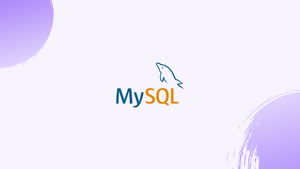Introduction
Before we begin talking about how to check the MySQL version, let's briefly understand – What is MySQL?
The most common open-source relational database management system is MySQL (and its drop-in replacement MariaDB). Knowing which version of MySQL is installed on your server may be crucial in particular circumstances because there are some significant differences between them.
For instance, if you are installing an application that requires a specific MySQL version, you must first determine the version of your MySQL server before proceeding with the installation.
In this tutorial, you will check the MySQL version. We will also address a few FAQs on how to check the MySQL version.
Advantages of MySQL
- Speed: MySQL is known for its fast processing capabilities, making it ideal for high-performance applications.
- Scalability: With support for large datasets and concurrent users, MySQL can handle growth and adapt to increasing demands.
- Reliability: MySQL ensures data integrity through transaction support and ACID compliance, guaranteeing consistent and reliable results.
- Flexibility: Its open-source nature and compatibility with multiple platforms allow MySQL to be easily integrated into various environments.
- Community Support: Being widely used, MySQL benefits from an extensive community, providing resources, documentation, and assistance for developers.
From the Command Line
Assuming you have SSH access to the server, you can use a number of commands to determine the version of your MySQL.
mysqld is the name of the MySQL server binary. Run the binary while using the --version or -V option to obtain the server version:
mysqld --version
The command will output details regarding the MySQL version and then exit. The version of the MySQL server is 5.7.27 in this case :
Output
mysqld Ver 5.7.27-0ubuntu0.18.04.1 for Linux on x86_64 ((Ubuntu))
The client utility mysqladmin is used to carry out administrative tasks on the MySQL servers. Additionally, it can be used to query the MySQL version:
mysqladmin -V
The output will differ slightly from the preceding command:
Output
mysqladmin Ver 8.42 Distrib 5.7.27, for Linux on x86_64
From the MySQL Shell
The version of the MySQL server can also be found by using a command-line client tool like mysql.
Type mysql to connect to the MySQL server:
mysql
The version will be displayed on the screen after you are connected to the MySQL shell:
Output
Welcome to the MySQL monitor. Commands end with ; or \g.
Your MySQL connection id is 3
Server version: 5.7.27-0ubuntu0.18.04.1 (Ubuntu)
Query the version variables to obtain information about the MySQL version and other components:
SHOW VARIABLES LIKE "%version%";
Output
+-------------------------+-------------------------+
| Variable_name | Value |
+-------------------------+-------------------------+
| innodb_version | 5.7.27 |
| protocol_version | 10 |
| slave_type_conversions | |
| tls_version | TLSv1,TLSv1.1 |
| version | 5.7.27-0ubuntu0.18.04.1 |
| version_comment | (Ubuntu) |
| version_compile_machine | x86_64 |
| version_compile_os | Linux |
+-------------------------+-------------------------+
8 rows in set (0.02 sec)
You may also view the server version using a few additional statements and commands. Only the MySQL version will be shown by the SELECT VERSION() statement.
SELECT VERSION();
The STATUS command displays the version of MySQL as well as details about the server's status:
STATUS;
Using PHP
You may find out the version of the MySQL server using PHP if you are on shared hosting and do not have access to the command line or a MySQL client like PhpMyAdmin.
Using an FTP or SFTP client, upload the subsequent PHP file to the document root directory of your website. En sure you switch the my_user and my_password with an actual MySQL user account :
<?php
// Create a database connection.
$link = mysqli_connect("localhost", "my_user", "my_password");
// Print the MySQL version.
echo mysqli_get_server_info($link);
// Close the connection.
mysqli_close($link);
The version of the MySQL server will be visible on your screen when you open the file in your browser:
Output
5.7.27-0ubuntu0.18.04.1
FAQs to Check the MySQL Version
Is there a graphical user interface (GUI) method to check the MySQL version?
Yes, many GUI tools like phpMyAdmin, MySQL Workbench, or Navicat provide a graphical interface to easily view the MySQL version information.
How can I see the MySQL version from PHP code?
You can use the mysqli_get_server_info() function in PHP to retrieve the version information. Example: echo mysqli_get_server_info($conn);
What does the MySQL version number consist of?
The MySQL version number includes major, minor, and release numbers, along with optional suffixes indicating the release type (e.g., stable, beta).
Can I determine the MySQL version through phpMyAdmin?
Yes, after login, the MySQL version is usually displayed in the top-left corner or in the server information section of the phpMyAdmin interface.
Does the MySQL version impact compatibility with different programming languages or frameworks?
In most cases, MySQL version differences have minimal impact on compatibility, as standard SQL statements and APIs are generally backward compatible.
Is it recommended to have the latest MySQL version installed?
Keeping MySQL up to date is recommended for security, performance, and stability improvements. However, always ensure compatibility with your existing systems before upgrading.
Can I upgrade MySQL to a newer version easily?
Yes, upgrading MySQL to a newer version is typically straightforward. However, it's advisable to backup databases and follow the official MySQL documentation to ensure a smooth transition.
Conclusion
It is quite simple to determine the version of the MySQL server. You have learned several different methods to find the MySQL version running on your system.
If you have any queries, feel free to post a comment below, and we'll be happy to answer them.
